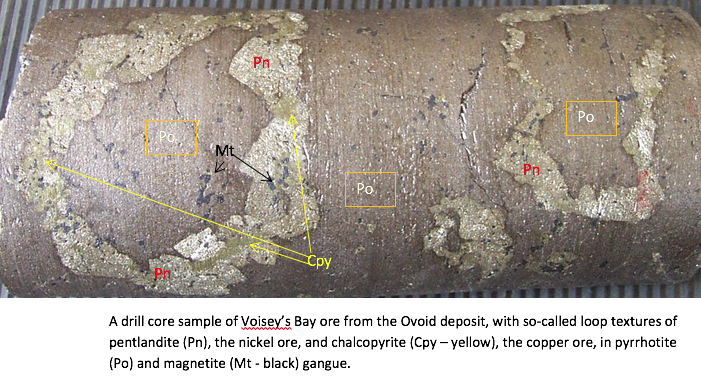'O' is for Ore
Submitted by Dr. Derek H. C. Wilton, Professor, Department of Earth Sciences, Faculty of Science, Memorial University.
Ore is a natural aggregate (best known as a “rock”) of one or more minerals which may be mined and sold at a profit, or from which some part may be profitably extracted. It is a technical term that has a precise definition. The key phrase is “sold at a profit.” Anybody can extract rocks with minerals from the Earth, but a rock is only considered to be ore if the material can be sold for more than it cost to extract it. Since the definition of ore is so dependent on profit, decreases in the world price of a particular ore being mined can mean that what was profitable one day (i.e., ore) can become non-profitable (i.e., not ore) the next day if the selling price drops below production costs. Another key characteristic is that ore is non-renewable: once extracted from the Earth it does not come back.

A number of factors can influence whether a mineral deposit actually contains ore. These can be subdivided into geological factors and non-geological, environmental-economic-social factors. Geological factors could include: (1) the physical characteristics of the ore mineral(s) and/or host rock; (2) the deposit’s depth below surface; (3) the host rock stability; and, finally, (4) grade and tonnage. Non-geological factors could include: (1) price for the ore on the world market; (2) politics; (3) location and distance from markets; (4) environmental concerns including potentially hazardous byproducts; (5) taxes; (6) production costs and wages; and (7) product replacement (if an ore becomes too expensive, then industry will develop replacement products).
Associated with ore is gangue, which is commercially valueless waste material that must be discarded when ore is extracted. An ore deposit is a three-dimensional volume of rock where the ore is concentrated above normal crustal abundances; typically 5x to 10,000x, depending on the specific ore.
The significance of a mineral deposit is expressed by two terms: (1) grade, which is the content of ore minerals expressed as a concentration compared to host rock; and (2) tonnage, which is the amount of rock that contains the ore at the specified grade (concentration). For instance, the Voisey’s Bay deposit is reported to contain 141 million tonnes of rock of which 1.63% is nickel ore, 0.85% is chalcopyrite ore, and 0.09% is cobalt ore. In other words, the deposit contains 141 million tonnes, with 2.57% ore and 97.43% gangue.
Ore deposits are typically described in terms of two end members with respect to the concentration of ore and amount (size) of ore-hosting rock. Some deposits are said to be high grade-low tonnage, if the grade of ore is high but amount of rock with the ore is low. Conversely a deposit which is very large, but has low ore concentrations, is said to low grade-high tonnage. The uranium deposits of central Labrador are good examples of this distinction. The Kitts deposit near Makkovik was considered to be relatively high grade, but low tonnage, as it was reported to contain 203,880 tons of rock with 0.73% U3O8 ore. In contrast, the Michelin deposit near Postville, reportedly contains 3,410,000 tonnes of rock with 0.07% U3O8 ore and is thought to large tonnage-low grade. The low grade-high tonnage type of deposit is typically extracted from open pit mines, as underground mining operations are generally too expensive based on the lower ore grade. The high grade-low tonnage types are mined either way.
When a mining or exploration company reports on the amount of ore in their deposits, according to Canadian law they have to present the data as “Exploration Information”. As such there are two classes of ore deposits reported, and these classes are based on the amount of data generated on the specific deposit. These classes are: (1) reserves, which are deposits in which the ore material is presently exploitable; and (2) resources, in which the deposit has potential ore, but is not necessarily exploitable due to market conditions or a lack of knowledge. Reserves can be further subdivided into (1) proven reserves, which are definitely ore; and (2) probable reserves, which most likely are ore, but some information may still be missing. Resources are subdivided into (3) indicated resources; and (4) inferred resources. The level of knowledge increases from inferred resources to proven reserves, but price fluctuations may transform a reserve into a resource.
In Labrador, ore is currently being mined at Voisey’s Bay (nickel-copper-cobalt) and in western Labrador at Labrador City (iron). Mineral deposits with indicated resources that might become ore are at Wabush (iron), Strange Lake (rare-earth elements) and Michelin (uranium). Inferred and indicated resources include rare-earth elements near Port Hope Simpson and copper in the Seal Lake region.
Back to all Encyclopedia entries